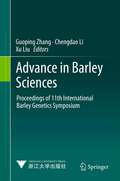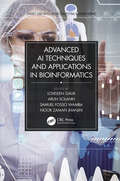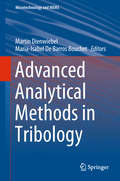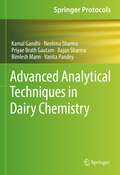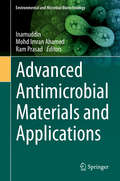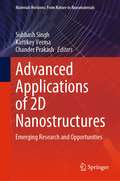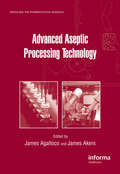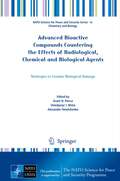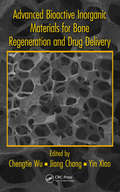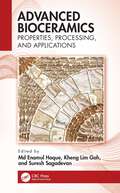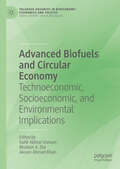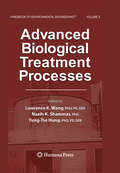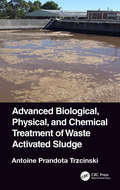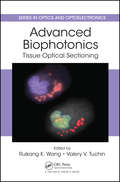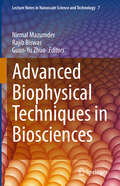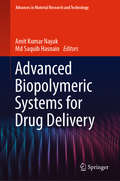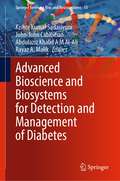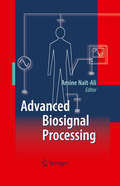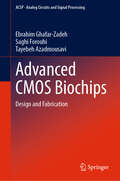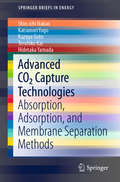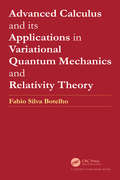- Table View
- List View
Advance in Barley Sciences: Proceedings of 11th International Barley Genetics Symposium (Advanced Topics In Science And Technology In China Ser.)
by Chengdao Li Guoping Zhang Xu LiuAdvance in barley sciences presents the latest developments in barley sciences. It collects 39 papers submitted to the 11th International Barley Genetics Symposium, and covers all presentation sessions of the conference, i.e., barley development and economy, utilization of germplasm, genetic resources and genetic stocks, end-uses, biotic stress tolerance, abiotic stresses, new and renewed breeding methodology, barley physiology, breeding success stories, barley genomics and all other '-omics.' Th e information will be useful for barley breeders, brewers, biochemists, molecular geneticists and biotechnologists. Th is book may also serve as reference text for students and scientists engaged in barley research. Dr. Guoping Zhang is a barley breeder and crop physiologist at the Department of Agronomy, Zhejiang University, China. Dr. Chengdao Li is a senior molecular geneticist and barley breeder at the Department of Agriculture and Food, Western Australia, Australia. He is also an adjunct professor at Murdoch University of Australia and Zhejiang University. Dr. Xu Liu, a member of the China Academy of Engineering, is a plant resources researcher at the Chinese Academy of Agricultural Sciences.
Advanced AI Techniques and Applications in Bioinformatics (Smart and Intelligent Computing in Engineering)
by Loveleen Gaur, Arun Solanki, Samuel Fosso Wamba and Noor Zaman JhanjhiThe advanced AI techniques are essential for resolving various problematic aspects emerging in the field of bioinformatics. This book covers the recent approaches in artificial intelligence and machine learning methods and their applications in Genome and Gene editing, cancer drug discovery classification, and the protein folding algorithms among others. Deep learning, which is widely used in image processing, is also applicable in bioinformatics as one of the most popular artificial intelligence approaches. The wide range of applications discussed in this book are an indispensable resource for computer scientists, engineers, biologists, mathematicians, physicians, and medical informaticists. Features: Focusses on the cross-disciplinary relation between computer science and biology and the role of machine learning methods in resolving complex problems in bioinformatics Provides a comprehensive and balanced blend of topics and applications using various advanced algorithms Presents cutting-edge research methodologies in the area of AI methods when applied to bioinformatics and innovative solutions Discusses the AI/ML techniques, their use, and their potential for use in common and future bioinformatics applications Includes recent achievements in AI and bioinformatics contributed by a global team of researchers
Advanced Analytical Methods in Tribology (Microtechnology and MEMS)
by Martin Dienwiebel Maria-Isabel De Barros BouchetThis book presents the basics and methods of nanoscale analytical techniques for tribology field. It gives guidance to the application of mechanical, microstructural, chemical characterization methods and topography analysis of materials. It provides an overview of the of state-of-the-art for researchers and practitioners in the field of tribology. It shows different examples to the application of mechanical, microstructural, chemical characterization methods and topography analysis of materials. Friction and Wear phenomena are governed by complexe processes at the interface of sliding surfaces. For a detailed understanding of these phenomena many surface sensitive techniques have become available in recent years. The applied methods are atom probe tomography, in situ TEM, SERS, NEXAFS, in situ XPS, nanoindentation and in situ Raman spectroscopy. A survey of new related numerical calculations completes this book. This concerns ab-initio coupling, numerical calculations for mechanical aspects and density functional theory (DFT) to study chemical reactivity.
Advanced Analytical Techniques in Dairy Chemistry (Springer Protocols Handbooks)
by Rajan Sharma Kamal Gandhi Priyae Brath Gautam Bimlesh Mann Neelima Sharma Vanita PandeyThis book compiles the advanced analytical techniques used in Dairy Chemistry research. It begins with the basic laboratory techniques and progresses towards techniques like spectroscopy, membrane processes, Western blotting etc. It provides step-by-step protocols for easy reproduction. It also provides troubleshooting guides. This one-of-a-kind protocols book is specifically designed for techniques used in Dairy Science research. It discusses all the necessary steps in different techniques, starting from sample preparations, standardizations and safety measures. It discusses the different techniques in assessing the quality of milk and milk products especially concerning to adulteration. It also includes the techniques used in assessing the active components in functional foods. The book is meant for students and researchers working in the field of Dairy and Food science. It is also useful for experts in the Dairy Industry.
Advanced Antimicrobial Materials and Applications (Environmental and Microbial Biotechnology)
by Inamuddin Ram Prasad Mohd Imran AhamedSurface bio-contamination has become a severe problem that contributes to outbreaks of community acquired and nosocomial infections through contiguous fomite transmission of diseases. Every year, thousands of patients die due to nosocomial infections by pathogens. It is therefore essential to develop novel strategies to prevent or improve the treatment of biomaterial concomitant infections. The concept of antimicrobial materials is becoming increasingly important not only in the hospital and healthcare environments, but also for laboratories, home appliances, and certain industrial applications. Materials are now being developed to prevent the buildup, spread and transfer of harmful microbes, and to dynamically deactivate them. Drawing on research and examples from around the world, this book highlights the latest advances in, and applications of, antibacterial biomaterials for biomedical devices, and focuses on metals with antibacterial coatings/surfaces, antibacterial stainless steels and other commonly used antibacterial materials. It also discusses the role of innovative approaches and provides a comprehensive overview of cutting-edge research on the processing, properties and technologies involved in the development of antimicrobial applications. Given its scope, the book will be of interest to researchers and policymakers, as well as undergraduate and graduate students of biochemistry, microbiology, and environmental chemistry
Advanced Application of Nanotechnology to Industrial Wastewater
by Maulin P. ShahThis book discusses new and innovative trends and techniques in the application of nanotechnology to industrial wastewater treatment both at a laboratory scale and an industry scale, including treatment, remediation, sensing and pollution prevention. The book also explores unique physicochemical and surface properties of nanoparticles; it highlights advantages they provide for engineering applications. Each chapter covers a different nanotechnology-based approach and examines basic principles, practical applications, recent breakthroughs and associated limitations. Nanotechnology applications to wastewater research have significant impact in maintaining the long-term quality, availability and viability of water. Regardless of the origin—for example, municipal or industrial wastewater—the remediation nanotechnology allows water to be recycled and desalinized in addition to simultaneously detecting biological and chemical contamination. The book describes a broad area of nanotechnology and water research where membrane processes (nanofiltration, ultrafiltration, reverse osmosis and nanoreactive membranes) are considered key components of advanced water purification and desalination technologies that remove, reduce or neutralize water contaminants. Various nanoparticles and nanomaterials that could be used in water remediation (zeolites, carbon nanotubes, self-assembled monolayers on mesoporous supports, biopolymers, single-enzyme nanoparticles, zero-valent iron nanoparticles, bimetallic iron nanoparticles and nanoscale semiconductor photocatalysts) are also discussed. This book is beneficial for students and academicians to understand the recent research advancements in the field.
Advanced Applications in Heat Exchanger Technologies: AI, Machine Learning, and Additive Manufacturing
by Sunil Kumar, Kavita Rathore, and Debjyoti BanerjeeAdvanced Applications in Heat Exchanger Technologies presents the most recent developments in enhancing heat exchanger performance, reliability, and resilience, including the implementation of Artificial Intelligence, Machine Learning, and Additive Manufacturing.Covering the essential parts of many commercial endeavors, ranging from aerospace to marine applications to oil-and-gas, the book discusses various heat exchanger types and interdisciplinary industry applications. It encompasses several different techniques, such as nanofluids, microchannel heat exchangers, computer modeling, advanced manufacturing, and optimization. The book addresses real-world concerns that impact long-term heat exchanger performance and dependability such as fouling, corrosion prevention, and maintenance measures.This book is intended for researchers and graduate students who are interested in heat exchangers R&D and the diverse range of industrial applications of heat exchanger technologies in contemporary practice.
Advanced Applications of 2D Nanostructures: Emerging Research and Opportunities (Materials Horizons: From Nature to Nanomaterials)
by Kartikey Verma Chander Prakash Subhash SinghThis book focuses on both recent advances and the applications of two-dimensional (2D) nanomaterials in different fields. This book encapsulates all the aspects related to 2D nanomaterials and their applications. It provides scientific and technological insights on novel routes of design and fabrication of few layered nanostructures and their hetero structures based on a variety of 2-D layered materials. It also covers a wide range of industrial applications of 2D nanomaterials. It emphasizes on the detailing of the various characterization techniques used. The book will be a valuable reference for beginners, researchers, and professionals interested in nano-materials and allied fields.
Advanced Aseptic Processing Technology (Drugs and the Pharmaceutical Sciences)
by James Agalloco James AkersThe preparation of sterile products using aseptic processing is considered perhaps the most critical process in the pharmaceutical industry and has witnessed continual improvement over the last half century. New approaches that have transformed classical aseptic production methods are appearing almost daily. This book reviews emerging technologies
Advanced Bifunctional Electrochemical Catalysts for Metal-Air Batteries (Electrochemical Energy Storage and Conversion)
by Jiujun Zhang David P. Wilkinson Yan-Jie Wang Rusheng Yuan Anna IgnaszakMetal-air batteries (MABs) have attracted attention because of their high specific energy, low cost, and safety features. This book discusses science and technology including material selection, synthesis, characterization, and their applications in MABs. It comprehensively describes various composite bifunctional electrocatalysts, corrosion/oxidation of carbon-containing air cathode catalysts, and how improvements can be achieved in the catalytic activities of oxygen reduction reaction and oxygen evolution reaction and their durability/stability. This book also analyzes, compares, and discusses composite bifunctional electrocatalysts in the applications of MABs, matching the fast information of commercial MABs in requirements. Aimed at researchers and industry professionals, this comprehensive work provides readers with an appreciation for what bifunctional composite electrocatalysts are capable of, how this field has grown in the past decades, and how bifunctional composite electrocatalysts can significantly improve the performance of MABs. It also offers suggestions for future research directions to overcome technical challenges and further facilitate research and development in this important area.
Advanced Bioactive Compounds Countering the Effects of Radiological, Chemical and Biological Agents: Strategies to Counter Biological Damage (NATO Science for Peace and Security Series A: Chemistry and Biology)
by Volodymyr I. Mizin Alexander Omelchenko Grant N. PierceThe probability for exposure to damaging radiation, toxic chemicals in the environment and adverse biological agents has increased exponentially today. The more frequent and faster travel that we experience today also escalates the risk of contraction and transmission of potentially deadly infections. This has created a very real and escalating risk for injuries and deaths. This is accentuated in the military and medical staff that is more frequently exposed to radiological, chemical, and biological agents in their normal working environment. Understanding the mechanisms whereby these toxic agents inflict damage to our bodies is essential to prepare us for these challenges. Much of the damage is inflicted through the generation of free radicals and non-radical oxidants which then act through oxidative mechanisms to injury the body. This volume will discuss the damage caused by these radiological, chemical, and biological environmental stressors, the mechanisms through which the damage can occur and the novel strategies that can be used to reduce the injury inflicted by these toxic compounds. Using basic and clinical research approaches, the contents of this book discuss new ideas for the development of bioactive products and environmental approaches to lessen or negate the biological damage inflicted by these noxious compounds.
Advanced Bioactive Inorganic Materials for Bone Regeneration and Drug Delivery
by Chengtie Wu Jiang Chang Yin XiaoBioceramics play an important role in repairing and regenerating defective or damaged bone. This volume reviews the latest advances in the field. Offering guidance for biomedical engineering researchers and material scientists, the book summarizes innovative concepts, bioceramic design, and methods for material synthesis and drug delivery. It covers design and fabrication of these materials, down to the nanoscale, and includes chapters on medical device engineering using these materials. The book is designed to enhance study and career development for those in this field and to facilitate further research and opportunities for new solutions.
Advanced Bioceramics: Properties, Processing, and Applications
by Kheng Lim Goh Md Enamul Hoque Suresh SagadevanAdvanced Bioceramics: Properties, Processing, and Applications describes development of bioceramics and biocomposites, which are used in various biomedical applications including bone tissue repair, remodelling and regeneration. It covers the fundamental aspects of materials science and bioengineering, clinical performance in a variety of applications, ISO/ASTM specifications, and opportunities and challenges. • Offers a comprehensive view of properties and processing of bioceramics. • Highlights applications in dentistry, orthopaedic and maxillofacial implants, and regenerative and tissue engineering. • Covers ISO/ASTM specifications such as processing, clinical applications, recycling/reuse and disposal standards. • Explores health, environmental and ethical issues. With contributions from eminent editors and recognized authors around the world, this book should serve as an important reference for academics, scientists, researchers, students and practitioners in materials science and biomedical engineering. It is to assist in the design of novel, targeted and personalised bioceramic-based solutions to advanced healthcare.
Advanced Biofuels and Bioproducts
by James W. LeeDesigned as a text not only for students and researchers, but anyone interested in green technology, Advanced Biofuels and Bioproducts offers the reader a vast overview of the state-of-the-art in renewable energies. The typical chapter sets out to explain the fundamentals of a new technology as well as providing its context in the greater field. With contributions from nearly 100 leading researchers across the globe, the text serves as an important and timely look into this rapidly expanding field. The 40 chapters that comprise Advanced Biofuels and Bioproducts are handily organized into the following 8 sections: · Introduction and Brazil's biofuel success · Smokeless biomass pyrolysis for advanced biofuels production and global biochar carbon sequestration · Cellulosic Biofuels · Photobiological production of advanced biofuels with synthetic biology · Lipids-based biodiesels · Life-cycle energy and economics analysis · High-value algal products and biomethane · Electrofuels
Advanced Biofuels and Circular Economy: Technoeconomic, Socioeconomic, and Environmental Implications (Palgrave Advances in Bioeconomy: Economics and Policies)
by Mudasir A. Dar Rahil Akhtar Usmani Akram Ahmad KhanThis book offers a holistic analysis of the role of advanced biofuels within the context of the circular economy. It provides a multidisciplinary perspective on cutting-edge developments in biofuel technology, including their sustainability impact, techno-economic and socio-economic considerations. This edited collection merges insights from environmental science, economics, and sustainability studies to provide a comprehensive understanding of the current landscape of advanced biofuels. Each chapter explores the complex interplay of the circular economy with biotechnological advancement, analysing diverse aspects including biofuel production, impact on local communities, their role in sustainable development and job creation, role in long-term economic growth and tackling climate challenges. The book also offers practical guidance on assessing socio-economic impacts and navigating the regulatory landscape. This is a valuable resource for researchers in the bioeconomy, circular economy, agricultural and environmental economics, as well as policymakers looking to make informed decisions and contribute to sustainable practices.
Advanced Biological Treatment Processes: Volume 9 (Handbook of Environmental Engineering #9)
by Lawrence K. Wang Yung-Tse Hung Nazih K. ShammasVolume 9: Advanced Biological Treatment Processes in the Handbook of Environmental Engineering series provides critical insight into pollution-abatement engineering. This outstanding collection of methodologies is designed as a review of engineering systems currently being used, as well as their potential for use in pollution abatement. The book's expert panel of authors provides a look at a range of topics, including principles and kinetics of biological processes, vertical shaft bioreactors, upflow sludge blanket filtration, membrane bioreactors, column bioreactor, SBR, nitrification, denitrification, and emerging biological processes. Volume 9: Advanced Biological Treatment Processes and its sister book - Volume 8: Biological Treatment Processes - are indispensable as both basic biological treatment textbooks and comprehensive reference books for advanced undergraduate and graduate students, designers of waste treatment systems, scientists, and researchers. A gold-standard addition to The Humana Press series, Volume 9: Advanced Biological Treatment Processes gives readers a cutting-edge illustration of the theory and practice of biological abatement systems and their critical role in environmental issues today.
Advanced Biological, Physical, and Chemical Treatment of Waste Activated Sludge
by Antoine Prandota TrzcinskiRecently, research efforts aiming to improve energy efficiency of wastewater treatment processes for large centralized wastewater treatment plants (WWTPs) have been increasing. Global warming impacts, energy sustainability, and biosolids generation are among several key drivers towards the establishment of energy-efficient WWTPs. WWTPs have been recognized as major contributors of greenhouse gas emissions as these are significant energy consumers in the industrialized world. The quantity of biosolids or excess waste activated sludge produced by WWTP will increase in the future due to population growth and this pose environmental concerns and solid waste disposal issues. Due to limited capacity of landfill sites, more stringent environmental legislation, and air pollution from incineration sites, there is a need to rethink the conventional way of dealing with wastewater and the sludge production that comes with it. This book provides an overview of advanced biological, physical and chemical treatment with the aim of reducing the volume of sewage sludge. Provides a comprehensive list of processes aiming at reducing the volume of sewage sludge and increasing biogas production from waste activated sludge. Includes clear process flowsheet showing how the process is modified compared to the conventional waste activated sludge process. Provides current technologies applied on full scale plant as well as methods still under investigation at laboratory scale. Offers data from pilot scale experience of these processes
Advanced Biophotonics: Tissue Optical Sectioning (Series in Optics and Optoelectronics)
by Valery V. Tuchin Ruikang K. WangDespite a number of books on biophotonics imaging for medical diagnostics and therapy, the field still lacks a comprehensive imaging book that describes state-of-the-art biophotonics imaging approaches intensively developed in recent years. Addressing this shortfall, Advanced Biophotonics: Tissue Optical Sectioning presents contemporary methods and
Advanced Biophysical Techniques in Biosciences (Lecture Notes in Nanoscale Science and Technology #7)
by Nirmal Mazumder Rajib Biswas Guan-Yu ZhuoThis book presents an overview of advanced biophysical techniques that can be used to understand the physicochemical properties of biomolecules and biomaterials and expand their potential for biomedical applications. It is split into two parts, the first covering advanced biophysical techniques and the second covering bioscience applications. Adequate knowledge about the behavior of biomacromolecules is essential for standardizing their applications in various industries. These properties are strongly influenced by the composition, chain structure (e.g. linear or branch), linkage patterns, and molecular weight of the biomolecules. This book describes the various internal and external factors that develop the structural and functional properties of biomolecules. Further, it covers the advanced techniques that can be used to discover and enhance these properties, such as scanning electron microscopy (SEM), Fourier-transform infrared (FTIR) spectroscopy, X-ray crystallography, fluorescence spectroscopy, surface plasmon resonance, surface-enhanced Raman spectroscopy, force spectroscopy, optical tweezers, and more. It also covers high-performance liquid chromatography for biomolecule detection, including sample preparation, column selection, mobile phase determination, and the choice of an appropriate detector for the investigation. This book serves as a modern resource on the topic, providing an in-depth analysis of various important physicochemical properties as well as their wide range of applications, including in pharmaceuticals, bioimaging/sensing, cancer therapy, food sciences, textiles, scaffolds, drug delivery, and tissue engineering. Readers are presented with several invasive and non-invasive techniques that can be used for the characterization of biomacromolecules along with many types of physical, chemical, and physicochemical modifications that can be used to enhance their usage.
Advanced Biopolymeric Systems for Drug Delivery (Advances in Material Research and Technology #133)
by Amit Kumar Nayak Md Saquib HasnainThis book discusses the recent innovations in the development of various advanced biopolymeric systems, including gels, in situ gels, hydrogels, interpenetrating polymer networks (IPNs), polyelectrolyte complexes (PECs), graft co-polymers, stimuli-responsive polymers, polymeric nanoparticles, nanocomposites, polymeric micelles, dendrimers, liposomes and scaffolds. It also examines their applications in drug delivery.
Advanced Bioscience and Biosystems for Detection and Management of Diabetes (Springer Series on Bio- and Neurosystems #13)
by Kishor Kumar Sadasivuni John-John Cabibihan Rayaz A. Malik Abdulaziz Khalid A M Al-AliThis book covers the medical condition of diabetic patients, their early symptoms and methods conventionally used for diagnosing and monitoring diabetes. It describes various techniques and technologies used for diabetes detection. The content is built upon moving from regressive technology (invasive) and adapting new-age pain-free technologies (non-invasive), machine learning and artificial intelligence for diabetes monitoring and management. This book details all the popular technologies used in the health care and medical fields for diabetic patients. An entire chapter is dedicated to how the future of this field will be shaping up and the challenges remaining to be conquered. Finally, it shows artificial intelligence and predictions, which can be beneficial for the early detection, dose monitoring and surveillance for patients suffering from diabetes
Advanced Biosignal Processing
by Amine Nait-AliThrough 17 chapters, this book presents the principle of many advanced biosignal processing techniques. After an important chapter introducing the main biosignal properties as well as the most recent acquisition techniques, it highlights five specific parts which build the body of this book. Each part concerns one of the most intensively used biosignals in the clinical routine, namely the Electrocardiogram (ECG), the Elektroenzephalogram (EEG), the Electromyogram (EMG) and the Evoked Potential (EP). In addition, each part gathers a certain number of chapters related to analysis, detection, classification, source separation and feature extraction. These aspects are explored by means of various advanced signal processing approaches, namely wavelets, Empirical Modal Decomposition, Neural networks, Markov models, Metaheuristics as well as hybrid approaches including wavelet networks, and neuro-fuzzy networks. The last part, concerns the Multimodal Biosignal processing, in which we present two different chapters related to the biomedical compression and the data fusion. Instead organising the chapters by approaches, the present book has been voluntarily structured according to signal categories (ECG, EEG, EMG, EP). This helps the reader, interested in a specific field, to assimilate easily the techniques dedicated to a given class of biosignals. Furthermore, most of signals used for illustration purpose in this book can be downloaded from the Medical Database for the Evaluation of Image and Signal Processing Algorithm. These materials assist considerably the user in evaluating the performances of their developed algorithms. This book is suited for final year graduate students, engineers and researchers in biomedical engineering and practicing engineers in biomedical science and medical physics.
Advanced CMOS Biochips: Design and Fabrication (Analog Circuits and Signal Processing)
by Ebrahim Ghafar-Zadeh Saghi Forouhi Tayebeh AzadmousaviBiochips incorporate a verity of means including electronic, photonic and microfluidic devices; biological materials (living cells, tissue, enzymes, nucleic acid and etc.) and chemical analysis to produce the detectable signals for identification of biological phenomena. Among several competing biochip technologies, Complementary Metal Oxide Semiconductor (CMOS) process offers the advantages of low cost, integrated, high precision and portable techniques suitable for point-of-care diagnostics. Advanced CMOS Biochip takes multi-path approach: microelectronic design and implementation of bio-interfaces offering a vital contemporary view of a wide range of integrated circuits and system for electrical, magnetic, optical and mechanical sensing and actuating blocks and much more; classical knowledge of biology, biochemistry as well as microfluidics. The coverage is both practical and in depth integrating experimental, theoretical and simulation examples. By using Advanced CMOS Biochip, readers will have the fundamentals and design techniques to grasp the situation which arise typically in CMOS biochip devices.
Advanced CO2 Capture Technologies: Absorption, Adsorption, and Membrane Separation Methods (SpringerBriefs in Energy)
by Shin-ichi Nakao Katsunori Yogo Kazuya Goto Teruhiko Kai Hidetaka YamadaThis book summarises the advanced CO2 capture technologies that can be used to reduce greenhouse gas emissions, especially those from large-scale sources, such as power-generation and steel-making plants. Focusing on the fundamental chemistry and chemical processes, as well as advanced technologies, including absorption and adsorption, it also discusses other aspects of the major CO2 capture methods: membrane separation; the basic chemistry and process for CO2 capture; the development of materials and processes; and practical applications, based on the authors’ R&D experience. This book serves as a valuable reference resource for researchers, teachers and students interested in CO2 problems, providing essential information on how to capture CO2 from various types of gases efficiently. It is also of interest to practitioners and academics, as it discusses the performance of the latest technologies applied in large-scale emission sources.
Advanced Calculus and its Applications in Variational Quantum Mechanics and Relativity Theory
by Fabio Silva BotelhoThe first part of this book reviews some key topics on multi-variable advanced calculus. The approach presented includes detailed and rigorous studies on surfaces in Rn which comprises items such as differential forms and an abstract version of the Stokes Theorem in Rn. The conclusion section introduces readers to Riemannian geometry, which is used in the subsequent chapters. The second part reviews applications, specifically in variational quantum mechanics and relativity theory. Topics such as a variational formulation for the relativistic Klein-Gordon equation, the derivation of a variational formulation for relativistic mechanics firstly through (semi)-Riemannian geometry are covered. The second part has a more general context. It includes fundamentals of differential geometry. The later chapters describe a new interpretation for the Bohr atomic model through a semi-classical approach. The book concludes with a classical description of the radiating cavity model in quantum mechanics.
